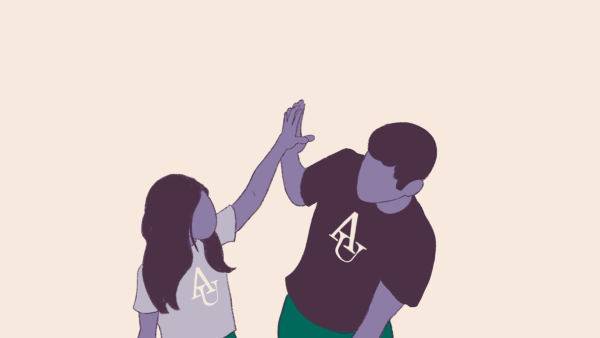Paintings, Parties and Performances: The Many Faces of the Katzen Arts Center
Last year, AU announced its decision to replace the Art History Department’s most prized, high-tech classroom with a welcome center for prospective students. Art History isn’t the only department whose academic operation has been subordinated for the sake of AU public relations — it seems that simply being housed in the Katzen Arts Center is enough to relegate a program to second-class status.
Katzen is like an adopted home for AU’s art, music and theater majors. They practice, perform, exhibit and occasionally sleep in its halls. But any student who has taken a class in Katzen is familiar with the building’s other, less academic use: event space. It’s not uncommon to arrive to practice an instrument or work on a painting only to find yourself in the middle of a black-tie charity event, a reception or a speech. Nor is it uncommon to go to class and come out hours later to find the entire building transformed into an elegant ballroom.
Prior to the construction of Katzen, the Arts and Performing Arts departments were scattered around campus, housed in Watkins, McKinley, Kreeger and other buildings certainly less than ideal for arts programs. Don Kimes, former Art Department chair and current professor, said that when he arrived at AU in 1988, plans for a new arts building were already underway.
Event hosting wasn’t originally part of the plan for the new building, according to Kimes; but it wasn’t long before “there was recognition of the fact that it was really a great space and they could generate revenue by renting it out, instead of hiking tuition.”
According to AU’s website, the building’s rotunda can be rented for an entire day for $1,200. Katzen has played host to art auctions, performances, receptions and even weddings. Originally, however, the plans for the building were strictly academic, laying out spaces for the AU Museum and the rotunda, which, according to Kimes, was to be a space for exhibitions of student work.
Outside art shows often appear on the walls of the building, puzzling students who know nothing of the work save that it is not generated by AU students or faculty. It’s fine to bring outside talent to AU, but events held in the rotunda sometimes demand that student art be removed from its walls for the duration of the event. In these instances, “the showing of student work becomes secondary to the event,” sculpture professor Andy Holtin said. For a studio art major, this undermines a necessary and valuable component of the artistic process.
Except for when classes were canceled last fall for the President’s Dinner, events do not make student work impossible. They can, however, make it problematic. Events are often attended by guests in suits, ties and evening gowns, which is a bit awkward for students dressed in painting clothes. It’s natural to feel odd walking through a stranger’s wedding, but here, students are being made to feel unwelcome in the building in which they are required to work.
“Practicing our instruments, drawing, painting, rehearsing — these are equivalents of studying,” said AJ Welch, a senior performance music major. “You wouldn’t stage a wedding in the middle of the library.” And while rehearsal requires less solemnity than the library, events are still disruptive. Students in Kogod or Hurst would be mystified by the presence of bridesmaids. In Katzen, you get used to it.
Assistant art professor Isabel Manalo cited incidents when student work was removed from display locations without instructors being notified. In some cases, it was later found stacked haphazardly in unused classrooms. This sort of treatment shows a lack of respect for student work, but also reveals problems involving communication, organization and the structural failing of the Katzen building to serve one of its primary purposes. Manalo hopes that “the art departments and the building can work together” to use the space in a mutually agreeable way.
Jason Lurie, Facilities Manager for the Katzen building, stresses that academics have always been a priority, saying that for every one private event hosted at Katzen, 10 to 15 more are rejected. “Students come first,” Lurie said. “And we work to minimize any type of academic interference.” Katzen, he said, has become the ideal venue for many events, whether related to AU or not, but everyone, including the University President, has to go through the same process to rent out the building.
“We are trying to accommodate everybody,” Lurie said.
Far from feeling accommodated, though, many students feel no more than a grudging tolerance toward Katzen events — mostly because free food is often provided, which Katzen students take as payment for dealing with the interruption events cause. It seems the “starving artist” stereotype is alive and well. •
Art by Emily Reid.












